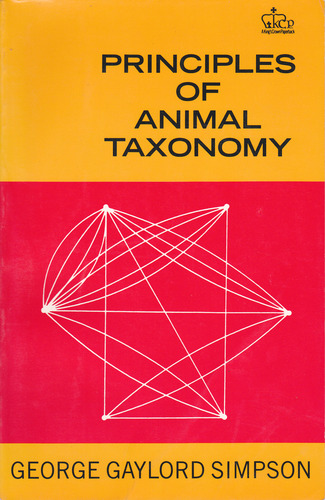Principles of animal taxonomy ebook download
Par wray reina le vendredi, décembre 23 2016, 21:56 - Lien permanent
Principles of animal taxonomy by George Gaylord Simpson


Principles of animal taxonomy George Gaylord Simpson ebook
ISBN: 023109650X, 9780231096508
Format: djvu
Publisher: Columbia University Press
Page: 131
Principles of Animal Taxonomy (no.20). The principle behind the method is illustrated in Figure 1, which shows a single species splitting into two independently evolving populations that gradually diverge over time. Tree of Life representations became popular in scientific works, with known fossil groups incorporated. Taxonomic aids, keys, specimen management ; Systematic and binomial system of nomenclature; Classification of living organisms( five kingdom classification, major groups and principles of classification within each group) Salient features of animal? Simpson GG (1961) Principles of Animal Taxonomy. Exclusive excerpt from Lord Robert May's book, Theoretical Ecology: Principles and Applications, published by Oxford University Press, 2007. The process of classifying and giving names to plants and animals was extensively studied by Berlin [3] who defines general principles to ethnobiological categorization and nomenclature. Hunn [13] Our objective, in this study, is to record the fishers' knowledge in relation to cetaceans, with special emphasis on folk taxonomy (ethnotaxonomy), analyzing fishers' forms of classification and nomenclature of whales and dolphins in the Southeastern Brazilian coast. Excerpt from Theoretical Ecology: Principles and Applications. Comparison of exotic horn types The heroic age of biological taxonomy is long over, but anatomy as an explanatory principle is still able to take over with a special convincing force any wonderful being from the world of legends to our one. ( nonchordates up to phylum level and chordates up to class level). Structural organisation in plants and animals. While he continued throughout his lifetime to revise and expand this great work, so his successors have continued to revise the principles of taxonomy, now according to genetic principles, informed by the analysis of DNA. With Darwin's theory, a general acceptance that classification should reflect the Darwinian principle of common descent quickly appeared. The system that we still use today for giving scientific names to plants and animals has many founders, from the Greek philosopher Aristotle to the Swedish physician and botanist Carolus Linnaeus. Each recently discovered new animal or prodigious being became understandable and inserted in the common system for once as soon as its anatomy was described and, first of all, depicted. Species conservation and systematics: the dilemma of subspecies. Scarcely a decade ago, Simpson (1961) matter-of-factly concluded that for the protists "evolutionary classification is not yet practicable. By method authors mean an arrangement of minerals, plants, and animals according to the principles of logical division.